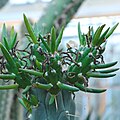| Austrocylindropuntia subulata | |
|---|---|
 | |
| Young plant | |
| Scientific classification | |
| Kingdom: | Plantae |
| Clade: | Tracheophytes |
| Clade: | Angiosperms |
| Clade: | Eudicots |
| Order: | Caryophyllales |
| Family: | Cactaceae |
| Genus: | Austrocylindropuntia |
| Species: | A. subulata |
| Binomial name | |
| Austrocylindropuntia subulata | |
| Synonyms [2] | |
| |
Austrocylindropuntia subulata is a species of cactus native to the Peruvian Andes. The Latin specific epithet subulata means "awl-like", referring to the shape of the rudimentary leaves. [3] It is also known by its common names as Eve's pin and Eve's needle.










